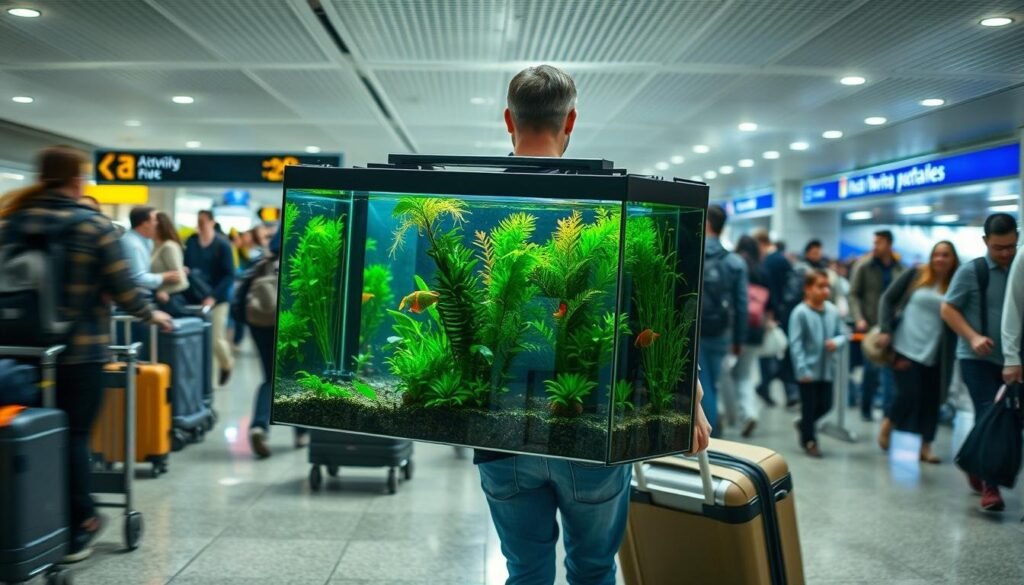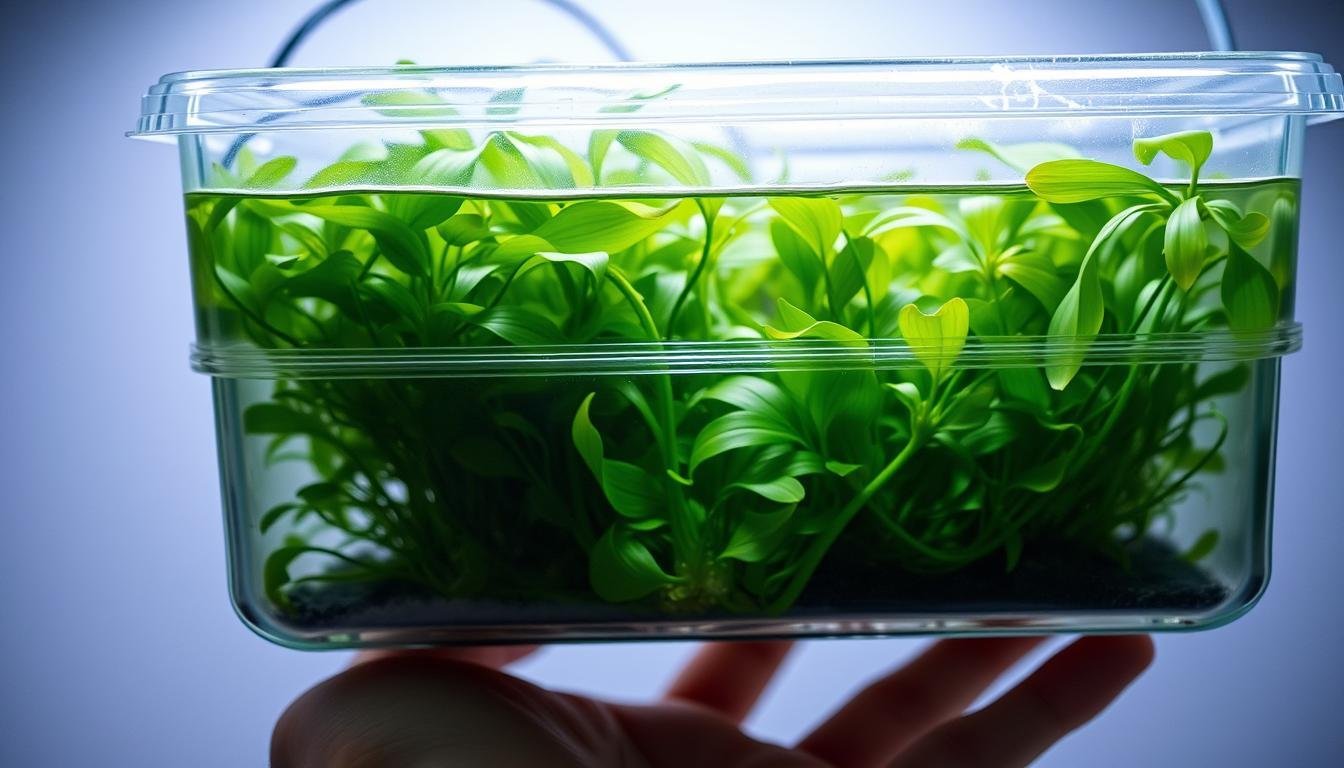Bring Aquarium Plants on a Plane: Traveling with aquatic treasures can be tricky, especially with transporting aquarium plants. If you’re taking your favorite plants on a trip, knowing the transport rules is key.
Airlines have different rules for live plants. It’s important to know these airline regulations for plants before you fly. Checking with your airline early can avoid problems at the airport.
Knowing the rules and preparing well will make your trip smooth for you and your plants.
Contents
- 1 Understanding TSA and Airline Regulations for Plants
- 2 Can You Bring Aquarium Plants on a Plane? The Basic Rules
- 3 Types of Aquarium Plants and Their Transportability
- 4 Proper Packing Methods for Aquarium Plants
- 5 Required Documentation for Plant Transportation
- 6 Potential Challenges When Flying with Aquarium Plants
- 7 Tips for Successfully Transporting Aquarium Plants by Air
- 8 Conclusion: Bring Aquarium Plants on a Plane
- 9 FAQ
- 9.1 Can I bring live aquarium plants on a domestic flight within the United States?
- 9.2 Are there any specific requirements for carrying aquarium plants in my carry-on luggage?
- 9.3 Do I need a phytosanitary certificate to transport aquarium plants on a plane?
- 9.4 How should I pack my aquarium plants to ensure they survive the flight?
- 9.5 Can I transport aquarium plants in checked luggage?
- 9.6 What should I do if my flight is delayed or canceled, and I’m traveling with aquarium plants?
- 9.7 Are there any specific aquarium plants that are more suitable for air travel than others?
Understanding TSA and Airline Regulations for Plants
Before you take your aquarium plants on a plane, learn about TSA rules and your airline’s policies. The Transportation Security Administration (TSA) has rules for plants at security checkpoints. It’s also key to know how airlines treat these items.
The TSA lets you bring plants through security, but they must be screened. This could be by X-ray or hand check. To help, pack your plants in a clear, quart-sized zip-top bag or a container that’s easy to open.
Airlines have their own rules for plants, too. Some might have special needs or limits for plants in checked or carry-on bags. So, always check with your airline before you go.
When you ask about your airline’s policy, consider these questions:
- Are there any specific packaging requirements for plants?
- Can plants be carried in both checked and carry-on luggage?
- Are there any additional fees associated with transporting plants?
- Are there restrictions on certain types of plants?
Knowing both TSA rules and your airline’s policies helps make your trip smoother. It’s good for you and your plants.
Can You Bring Aquarium Plants on a Plane? The Basic Rules
To travel with your aquarium plants without stress, knowing the basic air travel rules is key. There are specific guidelines and regulations for transporting plants. Following these can help avoid any problems on your trip.
The Transportation Security Administration (TSA) and airlines have set rules for flying with plants. Here are some important things to remember:
- Plants need to be packed well to avoid damage and spills during the flight.
- Some plants might need extra checks or inspections by the TSA.
- Always check with your airline about their rules for carrying plants. They might have different policies for plants in carry-on or checked bags.
- Some plants could be restricted or banned because of agricultural rules or worries about invasive species.
Before you go, consider these steps:
- Look up the rules at your destination for bringing in plants.
- Make sure your plants are pest and disease-free.
- Get any permits or documents needed for moving plants.
By knowing and following these basic rules, you can safely move your aquarium plants. This way, you can enjoy your trip without any plant-related problems.
Types of Aquarium Plants and Their Transportability
Different aquarium plants are better suited for air travel than others. It’s key to pick the ones that can handle the trip.
There are several types of aquarium plants. Floating plants like water lilies or duckweed are easy to move because they float. But, substrate-rooted plants like Anubias or Cryptocorynes need more care. They must stay moist and can get damaged easily.
For air travel, how well plants can be moved is a big deal. Some plants can get by with little care during the flight. Others need special attention. For example, plants like Java Moss or Cabomba are harder to move because they’re so delicate.
To understand better, here are some common aquarium plants and how easy they are to move:
- Easy to transport: Floating plants, succulents, and hardy stem plants.
- Moderate care required: Plants with rhizomes or those that need substrate.
- Difficult to transport: Delicate plants or those requiring precise water conditions.
When packing your plants, think about their needs. For carry-on, make sure they’re safe and won’t cause trouble. For checked luggage, keep them moist and safe.
Knowing which plants are best for travel helps you prepare for a smooth trip with your plants.
Proper Packing Methods for Aquarium Plants
Before you travel with your aquarium plants, it’s crucial to learn how to pack them properly. Proper packing is essential to maintain the health and integrity of your plants during the flight.
To pack your aquarium plants correctly, you should start by selecting the right container. A clear, sealable plastic bag or a specialized plant travel container is ideal. These containers help to maintain humidity and protect the plants from physical damage.
Maintaining Humidity and Temperature
Maintaining the right humidity and temperature is vital for the health of your aquarium plants during travel. You can achieve this by wrapping the plants in a damp cloth and placing them in a thermally insulated bag.
Here are some steps to follow:
- Wrap the roots of the plants in a damp cloth to maintain moisture.
- Place the wrapped plants in a sealable plastic bag to retain humidity.
- Use a thermally insulated bag to keep the plants at a stable temperature.
By following these steps, you can ensure that your aquarium plants remain healthy and thrive during and after the flight. It’s also a good idea to check with your airline for any specific requirements or restrictions on traveling with plants.
Required Documentation for Plant Transportation
Traveling with aquarium plants needs more than just packing them right. You also need the right paperwork. A key document is a phytosanitary certificate, given by the United States Department of Agriculture (USDA) or a state agency.
A phytosanitary certificate proves your plants are safe from pests and diseases. It’s often needed for international travel. But, some domestic flights might ask for it too. Always check with your airline and the destination’s rules.
Other Necessary Documents
Along with a phytosanitary certificate, you might need other papers. These include:
- Permits: Some plants need special permits for transport.
- Export and Import Certificates: For international travel, you might need certificates from both countries.
- Proof of Purchase or Ownership: Having receipts or other proof of plant ownership is useful.
It’s wise to make digital copies of all your documents. Leave a copy with someone you trust in case you need it while traveling.
Potential Challenges When Flying with Aquarium Plants
When you fly with aquarium plants, you’ll face several challenges. Moving these delicate organisms needs careful planning. You must also know the obstacles you might meet.
One big worry is the stress caused by changes in environment during travel. Aquarium plants don’t like changes in temperature, humidity, or light. These changes can be worse on a plane.

Layovers can be tough when you’re traveling with aquarium plants. It’s key to keep your plants healthy and stable during these times.
- Keep plants in a sealed, portable container to maintain humidity and temperature.
- Minimize exposure to extreme temperatures by keeping them away from direct sunlight or cold areas.
- If possible, inform the airline staff about your plants and ask for their assistance in handling them during the layover.
By knowing these challenges and taking steps ahead, you can lower the risks of flying with aquarium plants. This way, they’ll arrive at their destination healthy.
Tips for Successfully Transporting Aquarium Plants by Air
Transporting aquarium plants by air needs careful planning before and during the trip. First, make sure your plants are healthy and pest-free. This helps avoid problems during transport.
On the flight, keeping the right conditions for your plants is key. Pack them to reduce movement and prevent damage. A sealed, clear plastic bag helps keep humidity up and protects from dry air. It’s also essential to keep them away from extreme temperatures.
Here are some more tips for taking care of your plants during the trip:
- Keep the plants in a carry-on bag for careful handling.
- Avoid direct sunlight or extreme cold.
- Try to keep the plants moving as little as possible.
By following these tips, your aquarium plants will arrive safely and healthy. This makes all the effort worth it.
Conclusion: Bring Aquarium Plants on a Plane
Now you know the rules for flying with aquarium plants. You can plan your trip knowing what to expect. The TSA and your airline have rules to follow for a smooth trip.
To transport your plants by air, pack them right, get the right documents, and be ready for any issues. This way, you can enjoy your hobby anywhere you go.
Follow these tips to safely and easily transport your plants. This will make your travel experience enjoyable and worry-free.
See Also: Can You Bring Artificial Flowers on a Plane?
FAQ
Can I bring live aquarium plants on a domestic flight within the United States?
Yes, you can bring live aquarium plants on a domestic flight. But, you must check with your airline first. Also, follow the rules set by the Transportation Security Administration (TSA).
Are there any specific requirements for carrying aquarium plants in my carry-on luggage?
When carrying aquarium plants in your carry-on, make sure they are well-packaged. Be ready to take them out for TSA screening. It’s wise to tell the TSA officer about the plants beforehand.
Do I need a phytosanitary certificate to transport aquarium plants on a plane?
For travel within the United States, you usually don’t need a phytosanitary certificate for aquarium plants. But, for international travel, check the rules of the country you’re going to.
How should I pack my aquarium plants to ensure they survive the flight?
To keep your plants safe, pack them in a sealed, clear bag or a humid container. A thermally insulated bag can also help keep them cool or warm.
Can I transport aquarium plants in checked luggage?
You can put aquarium plants in checked luggage, but it’s not the best idea. There’s a risk of damage and extreme temperatures. If you must check them, use a strong, protected container.
What should I do if my flight is delayed or canceled, and I’m traveling with aquarium plants?
If your flight is delayed or canceled, act fast to care for your plants. Keep them in a cool, dry spot. Avoid extreme temperatures. You might need to change your travel plans for your plants.
Are there any specific aquarium plants that are more suitable for air travel than others?
Some aquarium plants are better for air travel. Java Moss, Anubias, and certain mosses are more resilient. They might do better than more delicate species.

Hello, I’m Janiyah Gibbs—a retired flight crew member and former TSA officer from Alaska, USA. At PlaneCarry.com, I share expert insights on what to carry (and avoid) when flying.

